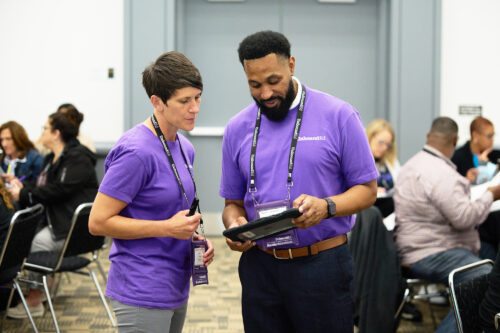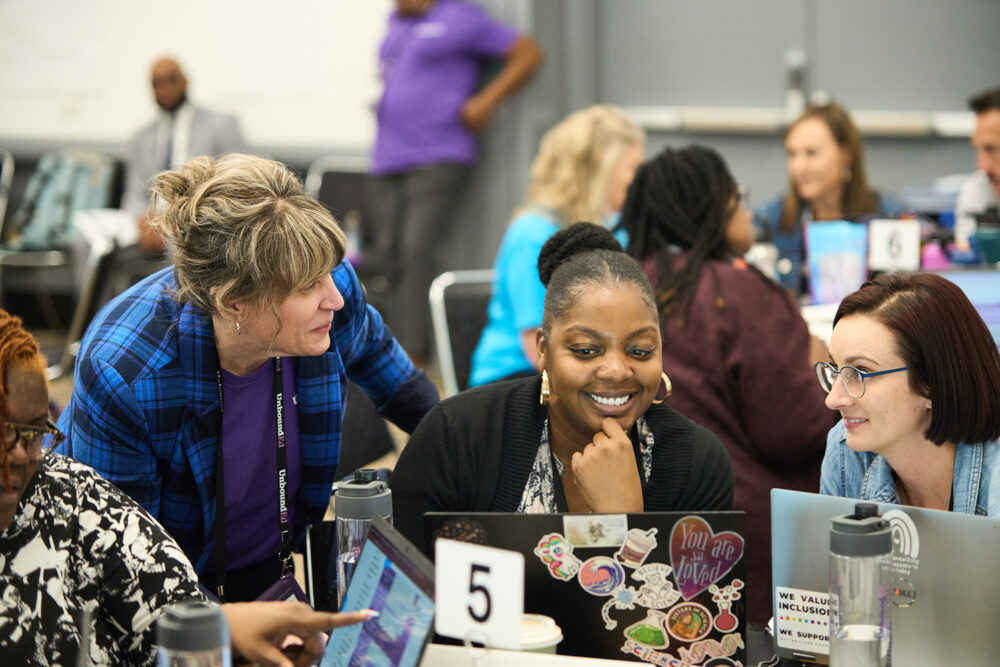Finally, Meet the Needs of Every Student
Today’s educators face a historic challenge. With engagement sliding, outcomes at risk, and students yearning for teaching that is affirming and meaningful, we need a fresh approach—one that feeds educators’ passion and fortifies instruction.
GLEAM™ instruction is the most impactful strategy for eliminating the predictability of student outcomes by race, language, and socioeconomic status to ensure all students thrive. At Standards Institute, courageous educators come together from across the country to forge a bold path toward truly transformative teaching and learning.
Our engaging, immersive pathways invite educators to experience, understand, and practice transformative instruction and leadership. Participants will reflect on current practice, commit to an action plan, and leave equipped and inspired to make every classroom GLEAM.
What to Expect
At Standards Institute, educators will learn:
- Content-specific, grade-level standards deeply
- To maintain academic rigor by fostering productive struggle and scaffolding
- Strategies for ensuring culturally, historically, and linguistically affirming and meaningful teaching and learning
- How to plan, design, and deliver GLEAM instruction
Educators will leave Standards Institute with:
- A shared understanding and language for fostering GLEAM instruction
- The mindsets, planning, skills, tools, and actions to deliver GLEAM instruction
- A personalized action plan with context-specific opportunities to ensure GLEAM instruction
- A national community of equity champions committed to growth and change
Contact Us to Learn More About Standards Institute
Why Standards Institute is Different
Standards Institute is not a traditional conference or workshop but an immersive 30-hour in-person course-like experience, where educators from around the nation actively come together in content- and grade-specific cohorts to hone their craft and make their instructional practices grade-level, engaging, affirming, and meaningful — GLEAM.
Over four days, educators learn to unpack and understand standards, scaffold instruction, and foster productive struggle. Educators leave equipped to uphold academic rigor, make teaching and learning engaging and affirming, and improve outcomes for all students.
Together, we can end the predictability of student outcomes by race, language, and socioeconomic status.
Start your GLEAM Journey at Standards Institute.
How We Organize the Learning
For Teachers and Coaches
-
English Language Arts (ELA) Pathway
Standards Institute™ ELA sessions focus on the supports and scaffolds that work to address students’ unfinished ELA instruction while maintaining the rigor of grade-level standards and curriculum. Educators will:
- Explore the commitment, knowledge, and skills necessary to use ELA standards, texts, and tasks to provide all students access to grade-level, engaging, affirming, and meaningful — GLEAM — instruction
- Leave with a personal action plan for bringing GLEAM instruction to life in their ELA classrooms
ELA Grade-Bands: K-5, 6-8, 9-12
-
Math Pathway
Standards Institute™ Math sessions offer participants interactive, hands-on experience planning and implementing grade-level, engaging, affirming, and meaningful — GLEAM — mathematics instruction. Educators will:
- Reflect on math identities and their impact on GLEAM math instruction
- Deepen their understanding of math instructional shifts (focus, coherence, rigor) to support GLEAM math instruction
- Learn a new approach to address students’ unfinished instruction that supports GLEAM math instruction within their school contexts
- Leave with a personal action plan for bringing GLEAM instruction to life in their math classrooms
Math Grade-Bands: K-5, 6-8, 9-12
-
Science Pathway
Standards Institute™ Science sessions offer participants a foundation in the principles and best practices in science instruction. The Science Pathway explores the Next Generation Science Standards and a vision for grade-level, engaging, affirming, and meaningful — GLEAM — instruction for all students. Participants will:
- Explore new ideas through hands-on lessons and investigations in different scientific domains
- Develop a repertoire of practical strategies to ensure that instruction exemplifies GLEAM
- Leave with a personal action plan for bringing GLEAM instruction to life in their science classrooms
Science Grade-Bands: K-5, 6-8, 9-12
-
UnboundEd Planning Process™ (UPP®) Pathway
UnboundEd Planning Process™ (UPP) sessions introduce participants to a set of powerful practices for bringing grade-level, engaging, affirming, and meaningful — GLEAM — instruction to life in ELA and math classrooms. Educators will:
- Explore the meaning and value of GLEAM instruction for all learners
- Learn a step-by-step strategy for applying GLEAM principles to any lesson and gain hands-on practice
- Leave with a personal action plan for bringing GLEAM instruction to life in their classrooms
UnboundEd Planning Process (UPP) Grade-Bands: K-5, 6-12
Note: K-5 participants will use both ELA and math lessons during the week; participants in grades 6-12 will use lessons in their preferred subject area — either ELA or math.
-
*NEW* Multilingual Learners Pathway
Standards Institute Accelerating English Language for Multilingual Students sessions, teachers and coaches receive research-based, high-leverage, immediately applicable resources, processes, and strategies to accelerate academic English development and build knowledge across content areas in the primary classroom. Educators will:
- Adapt standards-aligned lessons to support multilingual students in instruction for reading foundational skills, ELA, and math to ensure all students have access to grade-level, engaging, affirming, and meaningful — GLEAM — instruction.
- Leave with a repertoire of practical strategies and a personal action plan for bringing GLEAM instruction to life for multilingual students.
MLLs Grade-Bands: K-5
-
CORE Learning: Elementary Reading Academy
This pathway offers educators a strong foundation in standards-aligned and evidence-informed reading practices rooted in the science of reading. Educators will:
- Dive into the research on reading instruction and connect research to practice
- Develop high-leverage instructional practices (educational practices that can improve outcomes for every learner, like designing lessons in service of a goal, promoting active student engagement, collecting and assessing data, and more)
- Deliver standards-aligned and evidence-informed reading instruction
Elementary Reading Academy Grade-Bands: K-6
For Leaders
-
Leadership Pathway
The Leadership Pathway gives school and district leaders a foundation in the key concepts of ELA and math instruction in order to develop a deeper understanding of both subject areas. Participants will:
- Consider key components of planning, instructional delivery, and coaching that lead to grade-level, engaging, affirming, and meaningful — GLEAM — instruction.
- Assess their roles as leaders in advancing educational equity and operationalizing GLEAM within a school system
- Leave with a personal action plan to lead GLEAM instruction in their schools
Leadership Grade-Bands: K-5, 6-8, 9-12
-
CORE Learning: Leadership for Literacy
Participants in the Leadership for Literacy pathway will develop a foundational understanding of the science of reading and learn how to transform their instructional practices to accelerate student literacy. Leaders will:
- Learn practical knowledge about the science of reading and how to implement it across systems
- Develop tools, skills and processes for assessing school-wide literacy programs
- Identify leadership actions that help build professional capacity and introduce new opportunities for students to become successful readers and communicators
Leadership for Literacy Grade-Bands: K-5
Who is this for
Whether you’re a teacher, coach, principal, or district leader, there is a pathway for you.
Together, we can end the predictability of student outcomes by race, language, and socioeconomic status.


I learned so much from the Standards Institute. Not only did I gain a deeper understanding of the standards myself, I also learned ways to support and coach teachers on ways to ensure effective instruction based on the standards.
Principal

Register for Standards Institute Denver
Standards Institute™ Denver – 2024
JUNE 10 – 13, 2024


Register for Standards Institute DC
Standards Institute™ Washington, DC – 2024
JULY 15 – 18, 2024
